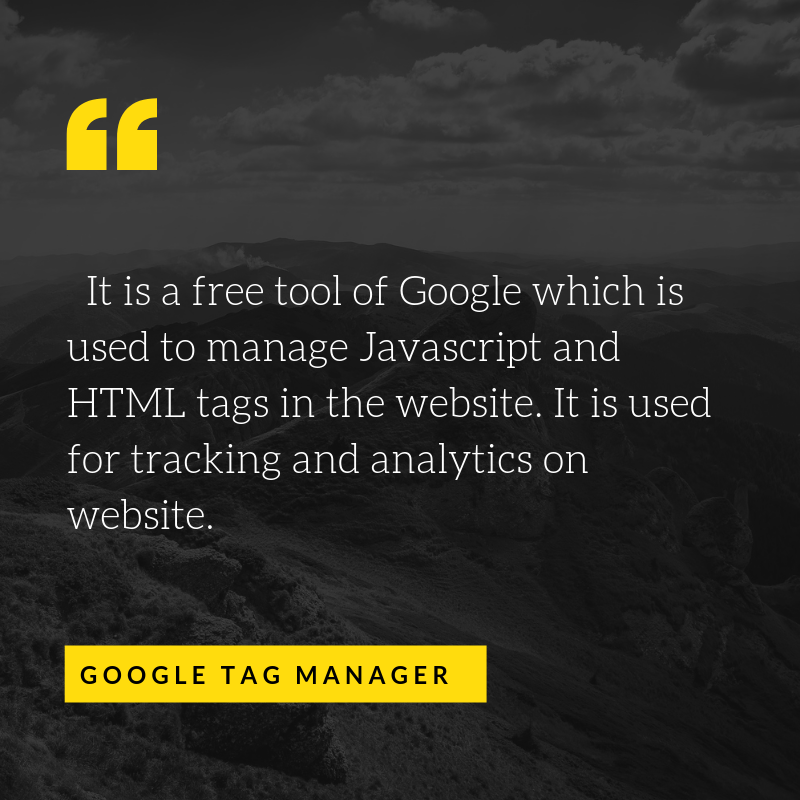
What is Google Tag Manager and How it works?
W Every Digital Marketing Agency relies on the best digital marketing techniques for the collection of data, either it may be a commercial business site, personal site or an e-commerce website or a small business, it requires the collection of data using digital marketing tools. First things first, it is predominant to understand how users are reaching your website. Digital Marketers interpret the user’s engagement on the site and monitor the behavior by using Google Analytics to collect the data. Google Analytics is the most used tool for the collection of data and it does provide some important analysis of data, but it becomes complex using only Google analytics to expand the reach of Business digitally and converting leads. Then, there comes the impeccable tool Google Tag Manager to optimize your marketing strategies and push your standards of online reachability. Data collection isn’t easy as said, but, by you can optimize by tagging your website with Google Tag Manager integrating with Google Analytics.

What is Google Tag Manager?
Google Tag Manager is a free conversion tracking tool to manage and report the tags embedded in your website. Tags are the snippets of code (JavaScript and HTML) that are used to track information from data sources.
Google Tag Manager makes your work easier by erasing the human error and efforts to write code for every tag you embed on the website. You can simply embed the code once into your website pages and then Google Tag Manager codes and embed the tags whenever you want to create a new tag. GTM is a very easy and user-oriented when you have to manage a bunch of tags on your website.
This process improves marketing efficiency, eradicates the human efforts to create tags and track conversions on your website.
Why is it used?
-
It eliminates the human error of coding each and every marketing tag and allows Digital Marketers to focus on expanding the Business and reachability
- Second, Google Tag Manager codes the tags on your website whenever you want to create a tag.
- Data collected from your website can be shared with Google Analytics through Google Tag Manager.
- Google Tag Manager stores and manages all the codes at one place and eliminates the need to rely on developers to code on the website source page.
- Google Tag Manager speeds up the process by embedding the codes and deploy on the website.
- It enables preview and debug mode to ensure that the codes are error-free and also check which tags are embedded on the page and which tags are not.
- In conjunction with Google Analytics, Google Tag Manager can also be used with Google Adwords and also manages other third party tags like Bing Ads, Crazy Egg, Hotjar, Adobe, Twitter and few other tags to be named.
- Just like Google Analytics Google Tag Manager is a free tracking tool which is used by many Businesses.
- Google Tag Manager has in-built tags for working on analytics, Adwords conversions, marketing. So, any digital marketer with zero coding knowledge can customize and create tags.
- Google Tag Manager will allow you to give account access to multiple people and at the same time can control the access and revoke any access at any time if found unmatched or malware.
- Google Tag Manager has various components like variables, triggers, containers, constants, data layers for tracking different tags and for different purposes to improve the data tracking.
- Another reason to use Google Tag Manager is that you can create own templates with simple and commonly used tracking codes. This is will be very useful for the Digital Marketing Agencies who run standard Google Analytics very frequent.
Read More: Facts about Search Engine Optimization
Is Google Tag Manager different from Google Analytics?
Yes, it is absolutely different from Google Analytics, both are different tools built by Google and when combined to keep on one platform and work to grow up the sites you wish, can produce efficient results by keeping a track on it.
Google Tag Manager is used to embed the tags on your website, export the data from one source to the other source and manage the tag codes working with google services and other third-party tags. Google Tag Manager makes the work easier by exporting all tags in one place and deploy on the website whenever you want to add tag to the website.
On the other side, Google Analytics integrated with Google Tag Manager can be used to track all information on the website like visitors behavior, the type of browser they are using, the number of visitors to your page. It also analyses and reports visitors activities like bounce rate, engagement, lead conversions, sales and etc.
But, this can only be done by adding tags to the website which is not possible with using only Google Analytics as there are a huge number of codes to track different activities, so, to ease the work and erase human errors Google Tag Manager is used to embed the tags on your website and collect data from the website.
How Google Tag Manager is useful to implement on your website?
Once you understand the popularity and growth of Google Tag Manager, you can do pretty amazing things using GTM on your website
- You can create and customize the data sent to other sources like Google Analytics
- It is easy to set up the tags and track the basic behavior and analytic events PDF downloads, outbound links, button clicks and promotion track.
- It helps in loading the website faster depending on the number of tags you are adding to the website
- You can use it on Google products and works efficiently on third-party tags as well.
- It helps in testing the tags used and erase the tags if detected as an error
- Ensures to export, store and manage all the tags at one place to avoid the mess up
- Google Tag Manager allows you to check and preview anything before it is live on the website!
- Google Tag Manager helps to track any form submissions on your page like contact us, submit forms with the help of Google Analytics
Read More: Digital Marketing company in Hyderabad
Drawbacks of Google Tag Manager?
Well, anything in this world is not made for perfection but to give a solution to a problem. Google Tag Manager has a few drawbacks so that digital marketers can keep this mind and work for better growth.
- Basic knowledge to set up Google Tag Manager in your system, it is advisable to grasp some basic information before setting up to avoid blathered guide.
- Requires lots of research and time investment if you are a beginner to use Google Tag Manager for your Business till you get a good grip on it.
- You need to spare some time to understand how to set up triggers, variables, tags using Google Tag Manager as there will be more troubleshooting issues initially.
4 Steps to follow for a well-organized reporting with Google Tag Manager
1. Implement Google Tag Manager to simplify the process of coding:
Google Tag Manager enables to add tags and tracking pixels all in one place. In general, most of the digital marketers add each tag and tracking pixels on each channel of every website, this creates a lot of clutter on the source code of the website. To make your work easier in adding up these tags and pixels it is highly recommended to install Google Tag Manager for better work efficiency.
2. Google Analytics Goals to compare the results:
After the set up of Google Tag Manager, it is essential to set up goals in your Google Analytics, It is always better to create custom goals so that it is easy to specify the destination URLs. Make sure that the goals set are always in sync with the paid ad conversions like demo request, free trial or add to cart. It is now easy to use Google Analytics to compare the results of the conversions on the website.
3. Use Google URL Campaign builder:
To check the behavior of visitors, ad conversions and specific traffic integrated with the goals set, it is highly recommended to use Google URL campaign builder to check the website visibility and other conversions.
4. Keep a track on your analytics and reporting:
To keep an eye on each channel goal and check the behavior of visitors on your site it is advisable to analyse and reports using Google Analytics aligned with Google Tag Manager. This will also allow you to check the page views bounce rate and customer conversions from ads leading to high ROI.
When Google Tag Manager is aligned with Google Analytics to maintain the harmony of the website, you can streamline the reporting of your website channel. Google Tag Manager plays a major role to implement the most advanced digital marketing strategies for successful organizational growth.
Visit us: Spark Infosys




